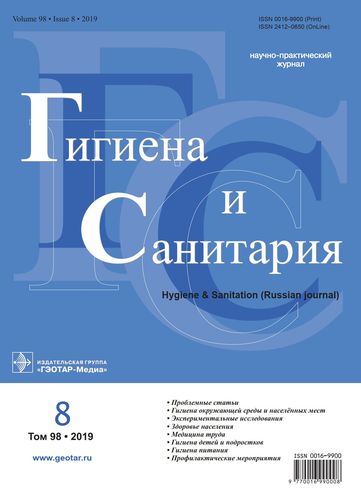Hygienic assessment of the safety and efficiency of using ultraviolet plants of the closed type for dsinfection of the air environment in the rooms of inpatient facilities
- Authors: Rakhmanin Y.A.1, Kalinina N.V.1, Gaponova E.B.1, Zagainova A.V.1, Nedachin A.E.1, Doskina T.V.1
-
Affiliations:
- Centre for Strategic Planning, Russian Ministry of Health
- Issue: Vol 98, No 8 (2019)
- Pages: 804-810
- Section: ENVIRONMENTAL HYGIENE
- Published: 15.08.2019
- URL: https://ruspoj.com/0016-9900/article/view/639655
- DOI: https://doi.org/10.47470/0016-9900-2019-98-8-804-810
- ID: 639655
Cite item
Full Text
Abstract
Introduction. The paper presents the results of the evaluation of the safety and efficiency of using UV irradiators-recirculators of a closed type, used for disinfecting air in the premises of medical facilities.
Material and methods. The studies included three types of UV irradiators-recirculators of the closed type of various brands. The safety assessment included: 1) ultraviolet radiation measurements; 2) the influence of devices on chemical pollution of indoor air; 3) the impact on the natural gas composition and microclimate; 4) measurement of ozone concentrations; 5) measurement of electromagnetic radiation; 6) measurements of sound levels.
Evaluation of the effectiveness of disinfection was performed on the total microbial number; the content of mold fungi and coliphages per 1 m3 of air.
Results. A safety assessment of the operation of closed-type ultraviolet irradiators-recirculators showed the devices under study, equipped with zone-free mercury lamps to be not sources of ozone and nitrogen dioxide emission into the air. However, from the bodies of two of the investigated devices, UV radiation with a wavelength of 200-280 nm was detected. It is established that UV irradiators-recirculators of the closed type can be sources of increased noise and electromagnetic radiation. The intensity of these factors inside of premises depends on the distance to the operating device. It is established the safe operating distance of such devices. It has been revealed that long-term operation of closed-type UV irradiators-recirculators can give rise elevation of the ambient air temperature and an increase in the concentration of saturated and acyclic hydrocarbons in the air. As a result of the evaluation of the disinfecting effect of the studied UV irradiators-recirculators, a different degree of effectiveness of their influence on the bacterial and fungal flora was established.
Conclusion. The necessity of developing a methodological document regulating the procedure and scope of research in assessing the safety and efficiency of using UV irradiators-recirculators of a closed type for disinfecting air in medical institutions in the presence of people is substantiated.
About the authors
Yu. A. Rakhmanin
Centre for Strategic Planning, Russian Ministry of Health
Author for correspondence.
Email: noemail@neicon.ru
ORCID iD: 0000-0002-5845-588X
Russian Federation
Natalya V. Kalinina
Centre for Strategic Planning, Russian Ministry of Health
Email: zhilsreda@yandex.ru
MD, Ph.D., leading researcher of the Centre for Strategic Planning, Russian Ministry of Health, Moscow, 119991, Russian Federation.
e-mail: zhilsreda@yandex.ru
Russian FederationE. B. Gaponova
Centre for Strategic Planning, Russian Ministry of Health
Email: noemail@neicon.ru
Russian Federation
A. V. Zagainova
Centre for Strategic Planning, Russian Ministry of Health
Email: noemail@neicon.ru
Russian Federation
A. E. Nedachin
Centre for Strategic Planning, Russian Ministry of Health
Email: noemail@neicon.ru
Russian Federation
T. V. Doskina
Centre for Strategic Planning, Russian Ministry of Health
Email: noemail@neicon.ru
Russian Federation
References
- Venzel R.P. Nosocomial infections. Moscow: Meditsina, 1990. 656 р. (in Russian)
- Znamensky A.V. Hospital hygiene: sanitary and epidemiological requirements for the design and operation of health care facilities. SPb.: Foliant; 2004. 240 р. (in Russian)
- Fedina N.V. The problem of professional risk and quality of life of doctors. Health Care in the Russian Federation. 2008; 6: 28. (in Russian)
- Izmerov N.F. Labor and health of physicians. Moscow: Real’noye vremya; 2005. 40 р. (in Russian)
- Wasserman A.L., Shandala, M.G., Yuzbashev V.G. The use of ultraviolet radiation to disinfect the air in the medical wards in a number of activities to prevent nosocomial infections. Polyclinic. 2013; 6: 74–6. (in Russian)
- Vasilyev A.I., Krasnochub A.V., Kuzmenko M.E., Petrenko Yu.P. Analysis of modern industrial sources of bactericidal ultraviolet radiation. Light Engineering. 2004; 6: 42–5. (in Russian)
- Novikova S.I., Prokopenko A.A. The spread of bactericidal UV radiation, depending on the type of emitter and application technology. Problems of Veterinary Sanitation, Hygiene and Ecology. 2016; 2: 58–61. (in Russian)
- Ziatdinov V.B., Badamshina G.G., Bakirov A.B., Zaripova A.Z., Isaeva G.Sh., Karimov D.O. Microbiological monitoring of the air environment in medical organizations. Occupational Medicine and Human Ecology. 2016; 4: 86–90. (in Russian)
- Punchenko O.E., Kosyakova K.G., Vasilyeva N.V. Investigation of air microbiota in multidisciplinary hospitals of St. Petersburg. Gigiena i sanitariya [Hygiene and Sanitation, Russian journal]. 2014; 93(5): 33–6. (in Russian)
- Kamrukov A.S., Kozlov N.P., Shashkovsky S.G., Yalovik M.S. Technologies and equipment for sanitation, microbiology and medicine. Life Safety. 2003; 1: 32–40. (in Russian)
- Meshcheryakov O.I. Solving the problem of clean air in outpatient work. Polyclinic. 2010; 3: 75–7. (in Russian)
- Kryuchkova O.B. Protection of nursing and junior medical personnel during the epidemiological period. Polyclinic. 2016; 6: 56–7. (in Russian)
- MSanPiN 001-96. Sanitary norms of permissible levels of physical factors in the application of consumer goods in the living conditions. Moscow; 1996. 16 р. (in Russian)
- R 3.5.1904-04. Using ultraviolet bactericidal radiation for disinfecting indoor air. Technical standard. Moscow; 2005. 52 р. (in Russian)
Supplementary files









